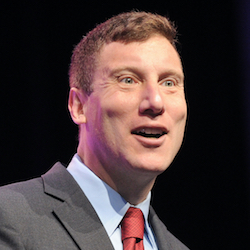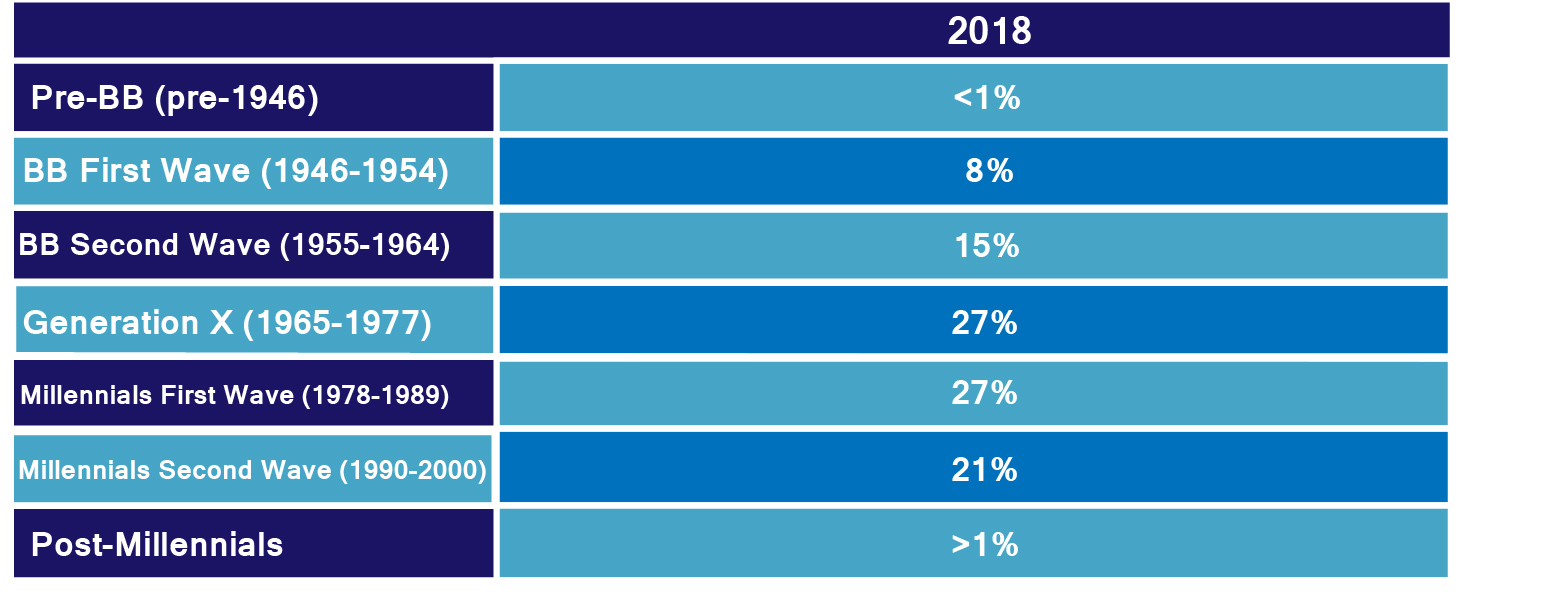
Demographers have been anticipating a radical change in the workforce for decades, a trend that we at RainmakerThinking call The Great Generational Shift.
In 2018, that transformation is well underway and has been for the past few years. This is not only a shift in the generational makeup of the workforce. The Great Generational Shift also is a shift in workplace norms and values, affecting everyone of all ages. There has been a transformation in the very nature of the employee-employer relationship.
Why is this generation gap so different from those of the past?
Based on our model, six generations are working side by side in 2018:
 Throughout history, in general, each new generation has brought new attitudes and expectations along with it. This is nothing new.
Throughout history, in general, each new generation has brought new attitudes and expectations along with it. This is nothing new.
What is new about the current generation gap, however, is that these new attitudes and expectations slowly and steadily are being embraced by everyone of all ages. Historically significant macro forces are driving change for everyone in the workforce, regardless of generation or career stage: globalization, technology, institutional insecurity, the growing information environment, increasing human diversity, and the creeping significance of online identities or personas in the real world.
We see these changes in the workforce reflected most obviously in millennials, who never have known it any other way. But here’s the real takeaway: Everyone is becoming more like millennials, not the other way around.
Rather than millennials “growing up and settling down,” in essence “becoming more like us of older generations,” we at RainmakerThinking have seen the inverse occurring in our research. Baby boomers and Gen Xers increasingly are likely to value, and seek out, jobs that offer what typically are considered “millennial” values, such as scheduling flexibility, work-from-home options and differential rewards based on actual employee performance rather than seniority or tenure.
Employees of all ages today are much less likely to be motivated by employers’ promises about long-term rewards that may or may not vest in the distant future. For younger employees, this is about maximizing opportunities to develop themselves and their careers, seeking the best employment options available to them at any given time, regardless of what we could call old-fashioned employer loyalty.
But whereas the number of baby boomers in the workforce is waning overall, a significant number of them want to work past typical retirement age. For them, short-term and transactional employment is a matter of getting the most that they can from their employers in the limited amount of time they have left in their working lives.
Considering the leadership gap affecting Gen X supervisors and managers, in which they have increasing responsibilities but insufficient support and guidance from experienced mentors, employers should be keen to hold onto their baby boomers for as long as they can. Wisdom and knowledge transfer are key factors that will make the difference between employers who succeed and employers who fail to adjust to the Great Generational Shift.
Here are three ways employers can retain baby boomers in 2018:
1) Part-time arrangements
If a valued baby boomer on your team is planning to retire, ask if he or she would consider continuing to work for you for just a little while longer, on a part-time basis.
The key to proposing this type of arrangement is to get at the heart of why that employee is planning to retire now, as opposed to later. Of course, freedom from employment is a powerful motivator, so the answer most likely will be something along the lines of wanting that freedom and flexibility, as well as relief from the stress and responsibilities that come with a high-powered position.
Tap into those wants and needs and see whether you can arrive at an employment offer that meets those needs. You may be surprised how quickly that baby boomer will decide that he or she does want to work for at least a little while longer, continuing to get paid while enjoying some of the benefits of retirement.
2) Working remotely
Remote work often is seen as a highly millennial trend, leveraging the latest technology and tools. But for baby boomers, remote work is yet another flexible arrangement that can provide a taste of retirement while still employed.
Skype and smartphones have revolutionized remote work for everyone, and it’s important to avoid making the mistake of assuming boomers can’t master new technologies due to their age.
3) Employing them in the future as consultants
If your baby-boomer employee is set on leaving your organization, it’s important to make sure that he or she leaves on the best of terms and that you have the ability to stay in touch after the employee leaves.
Several months down the line, you may find that you could really use this person’s expertise on a particular project or short-term initiative. Reach out to that former employee and offer to employ him or her as a contracted consultant – you might find that in retirement, this person is itching to have something to do!
Want to learn more about The Great Generational Shift? Download the free white paper from RainmakerThinking: The Great Generational Shift – Update 2018.
Bruce Tulgan is an adviser to business leaders all over the world and a keynote speaker and seminar leader. He is the founder and CEO of RainmakerThinking Inc., a management research and training firm, as well as RainmakerThinking.Training, an online training company. Tulgan is the best-selling author of numerous, books including Not Everyone Gets a Trophy (Revised & Updated, 2016), Bridging the Soft Skills Gap (2015), The 27 Challenges Managers Face (2014), and It’s Okay to be the Boss (Revised & Updated, 2014). He has written for the New York Times, the Harvard Business Review, HR Magazine, Training Magazine and the Huffington Post. Tulgan may be reached by e-mail at [email protected] and followed on Twitter @BruceTulgan. His website is www.rainmakerthinking.com.




